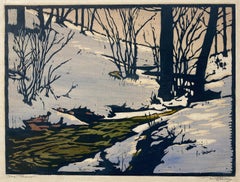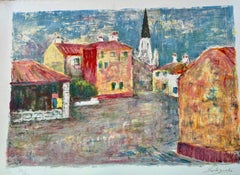René Quillivic Landscape Prints
to
2
Overall Width
to
Overall Height
to
2
2
180
169
146
131
2
2
1
1
2
2
1
1
1
1
2
2
Artist: René Quillivic
Brittany : Boats at the Harbour - Original wooodcut, Handsigned
By René Quillivic
Located in Paris, IDF
René Quillivic
Brittany : Boats at the Harbour, 1923
Original woodcut
Handsigned in pencil
Numbered /154
On vellum 32.5 x 25.5 cm (c. 13 x 10 in)
Bears...
Category
1920s Modern René Quillivic Landscape Prints
Materials
Woodcut
Brittany : Traditional Costume - Original wooodcut, Handsigned
By René Quillivic
Located in Paris, IDF
René Quillivic
Brittany : Traditional Costume, 1927
Original woodcut
Handsigned in pencil
Numbered /160
On vellum 32.5 x 25.5 cm (c. 13 x 10 in)
Bears ...
Category
1920s Modern René Quillivic Landscape Prints
Materials
Woodcut
Related Items
THE THAW
By William Seltzer Rice
Located in Santa Monica, CA
WILLIAM SELTZER RICE (1873 - 1963)
THE THAW c 1915-20
Color woodcut, signed and titled in pencil. Image 8 7/8 x 12 inches, sheet 10 3/4 x 14 3/8 inches. On textured fibrous paper. V...
Category
1910s American Modern René Quillivic Landscape Prints
Materials
Color, Woodcut
Village of Montmarte, Paris
By Shungo Sekiguchi
Located in Belgrade, MT
This piece is part of my private collection since the 1970's. It is an original color lithograph signed and numbered by the Japanese artist Shungo Sekiguchi. In 1935 Shungo Sekiguchi...
Category
Mid-20th Century Modern René Quillivic Landscape Prints
Materials
Lithograph, Woodcut
Stevan Dohanos, Backyard
By Stevan Dohanos
Located in New York, NY
Stevan Dohanos was an accomplished draftsman who work was widely known through the Saturday Evening Post. This print 'Backyard,' however, leaves aside the illustrative magazine work ...
Category
1930s American Modern René Quillivic Landscape Prints
Materials
Woodcut
1970 Tokio Mayashita-Rainy Street Woodblock Mid Century Modern
By Tokio Mayashita
Located in Brooklyn, NY
Limited edition woodblock print in colors seated in a black metal frame behind glass with a front profile of 1/4 inch and a side profile of 1 1/4 inch. Hand signed and numbered out o...
Category
1970s Modern René Quillivic Landscape Prints
Materials
Woodcut
$975 Sale Price
35% Off
H 27 in W 19.75 in D 2 in
A. Ross Pittman, Summer Home
Located in New York, NY
This print is signed and titled in pencil. A native of Tennessee and a physician, Pittman began to make prints in 1936 in Trenton, New Jersey. However, scene of his home state remain...
Category
1930s American Modern René Quillivic Landscape Prints
Materials
Woodcut
The Bridge
By Bror Julius Olsson Nordfeldt
Located in Santa Monica, CA
B. J. O. NORDFELDT (Bror Julius Olsson) 1878-1955)
THE BRIDGE, 1906
Color woodcut signed, dated 1906 and numbered 150 in pencil. Image 8 x 10 - small margins as issued. 4 corners tipped to acid free support board. Nordfelt is one of the most important early twentieth century American Masters of the Color woodcut. This 1906 work predates many of the other woodcut masters. Nordfeldt had a peculiar numbering system. The number is not necessarily the edition number.
Frances H. Gearhart, Blanche Lazzell, William S. Rice, Gustave Baumann, Margaret Patterson, Norma Basset Hall. Waldo Chase.
Category
Early 1900s American Modern René Quillivic Landscape Prints
Materials
Woodcut
DAITOKUJI KYOTO
By Kiyoshi Saitō
Located in Santa Monica, CA
KIYOSHI SAITO (Japanese 1907 - 1997)
DAITIKUJI KYOTO, 1957
Color woodcut, signed, titled, dated and no. 42/100 in pencil. Edition 100. Image 15 x 20 5/8 inches. Full margins with de...
Category
1950s Modern René Quillivic Landscape Prints
Materials
Woodcut
River Reflections
By Arthur Wesley Dow
Located in Fairlawn, OH
River Reflections
Color woodcut, c. 1910
Unsigned
Provenance: Dow Family Album, Cincinnati
Condition: Excellent
Image size: 2 1/2 x 4 inches
Sheet size: 3 1/8 x 4 7/8”
A color varian...
Category
1910s American Modern René Quillivic Landscape Prints
Materials
Woodcut
Werner Drewes, Winter, 1933, modernist woodcut
By Werner Drewes
Located in New York, NY
A modernist fantasy winter scene created by Werner Drewes, this print brings key aspects of the period together. His cubist-inspired woodcut technique is utilized here to bring the s...
Category
1930s American Modern René Quillivic Landscape Prints
Materials
Woodcut
THE SUNFLOWER
Located in Santa Monica, CA
ANDERS ALDRIN (Swedish /American 1889 – 1970)
THE SUNFLOWER ca. 1935 (Newark Museum 9)
Color woodcut, edition c. 150. Signed, unnumbered, but dedicat...
Category
1930s American Modern René Quillivic Landscape Prints
Materials
Woodcut
A Handsome Woodcut on Paper of the Univ. of Chicago Chapel by Siegfried Weng
Located in Chicago, IL
A handsome woodcut on paper of the University of Chicago Chapel by artist Siegfried Weng. A perfect gift for your U of C grad! Arwork size:
9 3/4" x 7 1/2". Archivally matted to...
Category
1920s American Modern René Quillivic Landscape Prints
Materials
Paper, Woodcut
Modern American Industrial Landscape
Located in Buffalo, NY
An original woodblock print dated 1965, titled "Our Town" but signed illegibly.
Category
1960s American Modern René Quillivic Landscape Prints
Materials
Paper, Woodcut
René Quillivic landscape prints for sale on 1stDibs.
Find a wide variety of authentic René Quillivic landscape prints available for sale on 1stDibs. You can also browse by medium to find art by René Quillivic in woodcut print and more. Much of the original work by this artist or collective was created during the 1920s and is mostly associated with the modern style. Not every interior allows for large René Quillivic landscape prints, so small editions measuring 11 inches across are available. Customers who are interested in this artist might also find the work of Samuel Chamberlain, Edmund Blampied, and Albert Marquet. René Quillivic landscape prints prices can differ depending upon medium, time period and other attributes. On 1stDibs, the price for these items starts at $755 and tops out at $863, while the average work can sell for $809.

